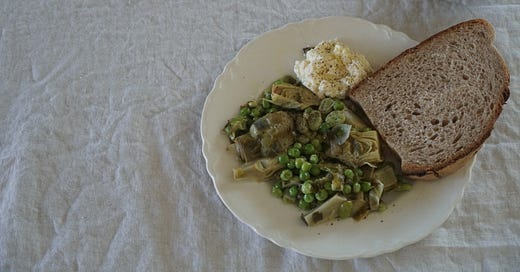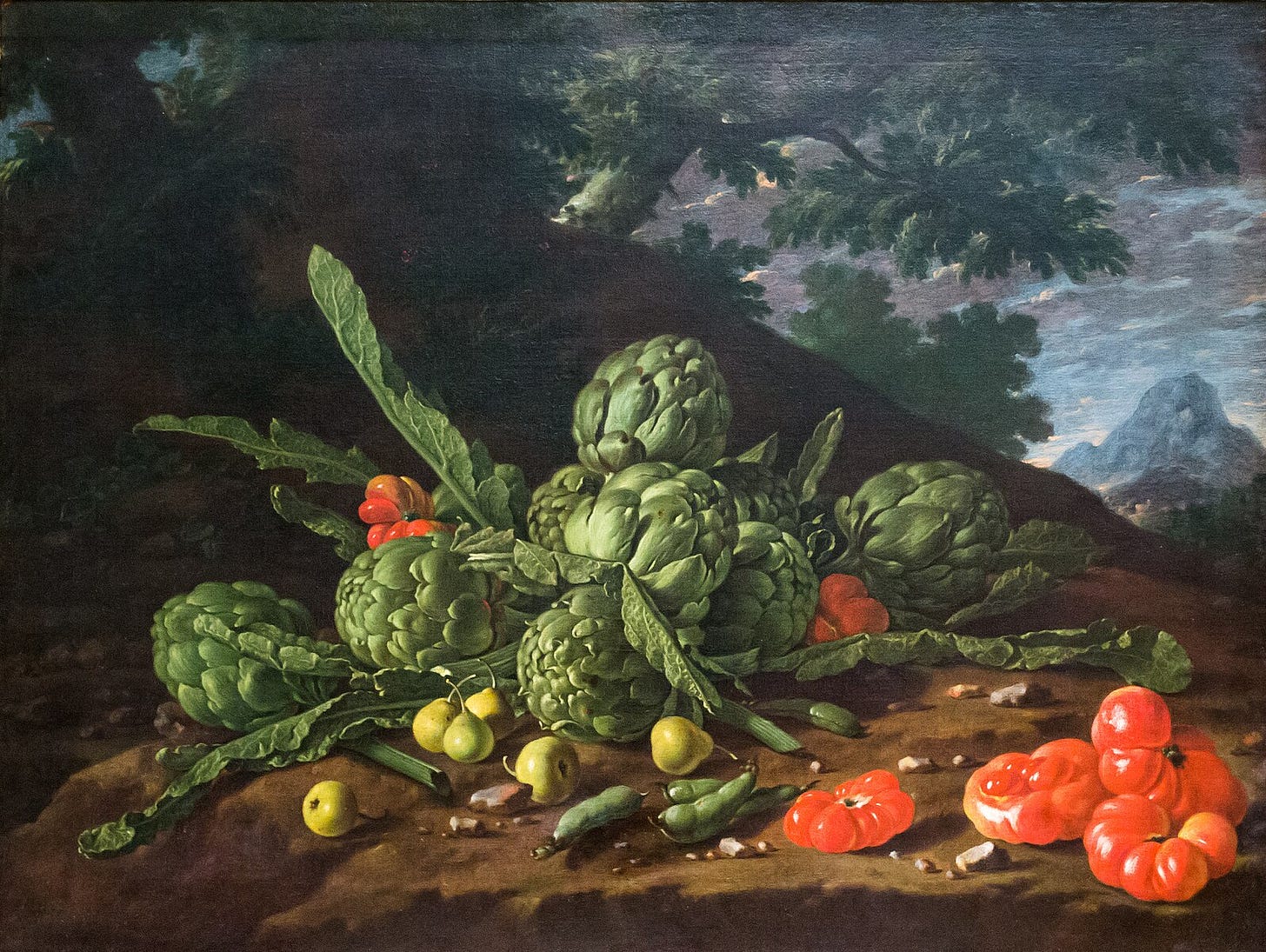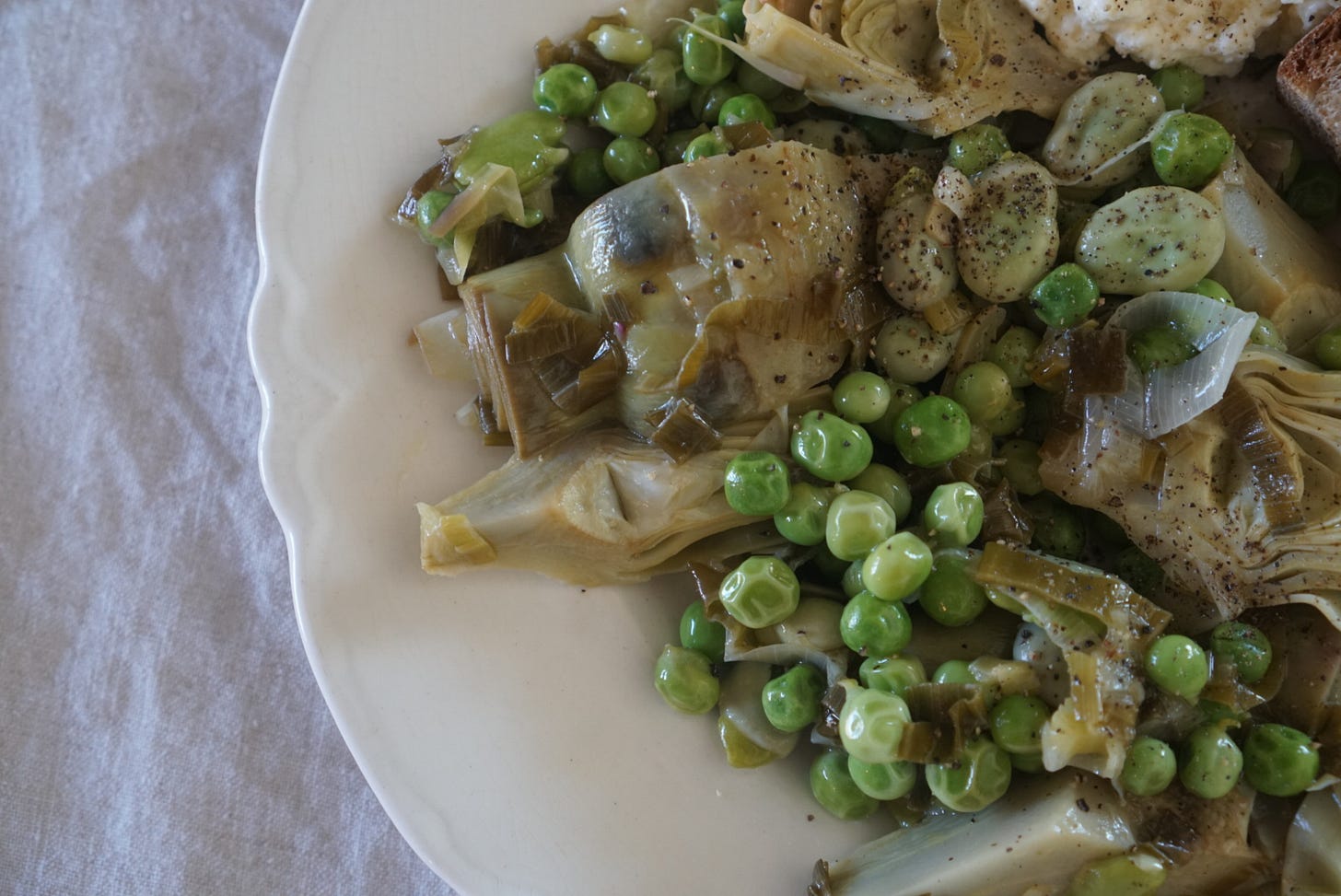Welcome to mama eats, a twice-weekly newsletter (Tues. & Sat.) inspired by a simple + seasonal home life. This week’s post includes three recipes for artichokes, two of which are viewable by all subscribers, and one (with video) which is only viewable by paid subscribers. I try to provide as much free content as possible, however, this newsletter is a labor of love and I am a busy mother of three. If you have the means and find value in what I share, please consider becoming a paid subscriber, which also gives you the benefit of access to the growing archive (posts over a month old).
note: a portion of this post is a reprint from a blog post I wrote in April 2019, with some edits. x A
I’ve come full circle with artichokes. I adored them as a kid, so many memories of boiling them whole, scraping them against teeth, a neat mound of mayonnaise to dip in, at my grandparents house. They always used Saffola mayonnaise, a particular taste, made with sunflower oil I think; completely different from the slightly sweet Best Foods mayonnaise my parents used. The little bitter edge always made me feel a bit grown up. The bowl on the table for the piles of leftover leaves, casualties, mounded into the compost after. The pleasantly slow process of dipping leaf after leaf foreshadowing the lovely lazy days of summer ahead. I always proudly gave away my artichoke heart to my dad, which I gasp at now, years of those tender hearts lost! I don’t know why, but I thought the heart too mushy. Now of course it is my favorite. It’s amazing how our food preferences can change so drastically over the course of our lives. Sometimes my mom baked and stuffed them and sometimes we bought store bought marinated ones which got thrown into pasta salads along with kidney beans, pepperoncini, and salami in the height of juicy summer.
After I moved out of the house, I never bought artichokes for years and years. I always thought them fussy and not particularly worth the effort. But Carmela loved artichokes and would beg for them, so I bought them occasionally, specifically for her. Then, one year, I saw little baby artichokes at the market, beautiful and as small as an egg, tinged a bit purple. How darling they looked sitting next to the giant globe artichokes. I impulsively brought them home and discovered they had no choke to speak of and with a bit of trimming, the whole thing was edible. What a revelation! I ate them weekly until they were no more, gone until next year, leaving me pining away. Such are the pleasures of seasonal eating.
In the following springs since, I’ve eaten all types of artichokes many ways- alla romana, with the elegant stems sloping upwards and braised into melting tenderness, in risottos, vignarola (recipe below), sauteed simply with olive oil and wine (recipe below), and of course the good old steamed or boiled whole, leaved dipped lovingly one by one into vinaigrette or mayonnaise. In addition, greedily hoping to extend the season a bit longer, I always set aside a Saturday afternoon to make carciofi sott’olio: in which the trimmed artichokes are boiled in an white wine, vinegar, and water mix before being left to dry out for 24 hours, then tightly packed in a meticulously clean glass jar and drowned in olive oil. Sott’olio is applied to many vegetables, eggplant, peppers, zucchini and such, often served as part of an appetizer spread. I eat mine just so out of the jar, with a slice of good bread to mop up some of the oil. Some of them are sliced and make their way into pasta salads, bean salads (with sliced raw sweet onion, cannellini beans, parsley etc) too. They also look beautiful on the pantry shelf, satisfying to see there, if like me, you feel comforted by shelves lined with things you made with your own hands.
Today, I’m sharing the recipe for the preserved artichokes, along with my favorite vignarola, and simple braised artichokes. I hope one of these recipes will find their way into your kitchen this spring, when you find artichokes at the market or in your garden. Even though they are a bit tough to work with, the yield is well worth the work. xx A
carciofi sott’olio (artichokes preserved under oil)
notes: if you cannot find baby artichokes (which actually are simply the secondary offshoots lower down on the plant stem), regular big artichokes will do, trimmed well, choke removed, and quartered. When choosing artichokes, be sure to choose fresh looking specimens- if you bend down a leaf it should snap really and brightly, not limply. The leaves should be nice and tight, and the stem should look relatively fresh. Trimming artichokes can be very intimidating for a beginner, I know I avoided them for years just because of that. Courage! I promise its actually not very difficult, just time consuming, once you get the hang of it, and if you’re armed with a good sharp paring knife. I quite enjoy it to be honest, a little vegetable meditation in action paying dutiful attention to the leaves, the feeling, the sounds of the leaves snapping. Perhaps pour a glass of wine, dance around the kitchen, enlist a friend, and put some good music on before you begin. It’s just the thing for a Saturday or Sunday. I do hope you enjoy making them if you take the plunge, I promise it will be worth it. xx
a lemon, sliced in quarters
3.25 lb / 1.5 kg baby artichokes
2.25 cups / 500 ml white wine
2.25 cups / 500 ml white wine vinegar
a bay leaf
sea salt
whole black peppercorns
olive oil, enough to fill the jar
a very clean glass jar with a lid
Begin by trimming the artichokes, rubbing the cut surfaces with lemon as you go. Snap off the tough outer leaves until you see the ones with a yellow base. Cut off the top third of the leaves which are dark green, tough and inedible and trim the stem. For a more detailed primer, check out Heidi Swanson’s excellent post on trimming artichokes.
Bring the white wine, vinegar, and 1 cup / 200 ml water to a boil with the bay leaf and a generous three finger pinch of salt. Add half the the artichokes, we don’t want to crowd them, and when the liquid comes back to the boil, stir them around and then set a timer for 3 minutes. Fish them out with a strainer and do the second batch. Leave them to sit in a colander in your (clean) sink until they’ve cooled enough to handle. Meanwhile, prepare a clean baking sheet or dish with a clean kitchen towel. Then, one at a time, take an artichoke, holding it upside down, and squeeze gently over the sink to get rid of any excess liquid. Place it right side up on the lined sheet. Repeat. Let the artichokes sit at room temp for 24 hours so that any remaining water can dry off them.
Pack them firmly into your very clean glass jar, alternating layers with a few black peppercorns (or dried chiles, cloves, or other dried spices if you wish). Pour in the olive oil, enough to completely submerge all the artichokes generously- you don’t want any exposure to air. Screw on the lid and set in a cool dark cupboard for at least 10 days- two weeks before eating, and up to 3-4 months.
braised artichokes
notes: this is not so much of a recipe as a method, this is why I have not put hard and fast amounts- it really does not matter much how many artichokes you want to use- I just always use the amount I have. These are delicious as a simple side, tucked into a square of foccacia for a sandwich, or stirred into a plain risotto at the end.
artichokes
a lemon
a generous few glugs of olive oil
a few fat cloves of garlic
a small glassful of white wine
salt
a few leaves of mint, optional
Trim the artichokes first- remove the outer leaves, keep going until the very tender, lightly yellow ones are left. Trim the stem a bit, and pare away the peel of it. Cut away any tough or dark green parts remaining from the base where you snapped away the leaves. Cut off the top third of the artichoke leaves, then rub all cut surfaces with lemon before moving on to the next artichoke.
When you have finished trimming all the artichokes, cut them into wedges, removing any hairy choke that you see, rubbing the cut surfaces with the lemon as you work. Slice the garlic into slivers.
Add the olive oil to a large skillet and warm it to medium heat. Add garlic and the artichoke quarters, turning well to coat in the oil, and sprinkle over salt generously. Saute for a minute or two before pouring over the wine. Cover the pan and reduce the heat to medium low, cooking until artichokes are tender, checking every so often to add a little water if needed. When artichokes are tender, remove the lid and turn the heat back up to medium high to let any remaining liquid evaporate. Season with salt and let cool a bit (this dish tastes best served warm or at room temperature) before scattering over the torn mint, if using.
Here is a small, sped up video showing my trimming process:








